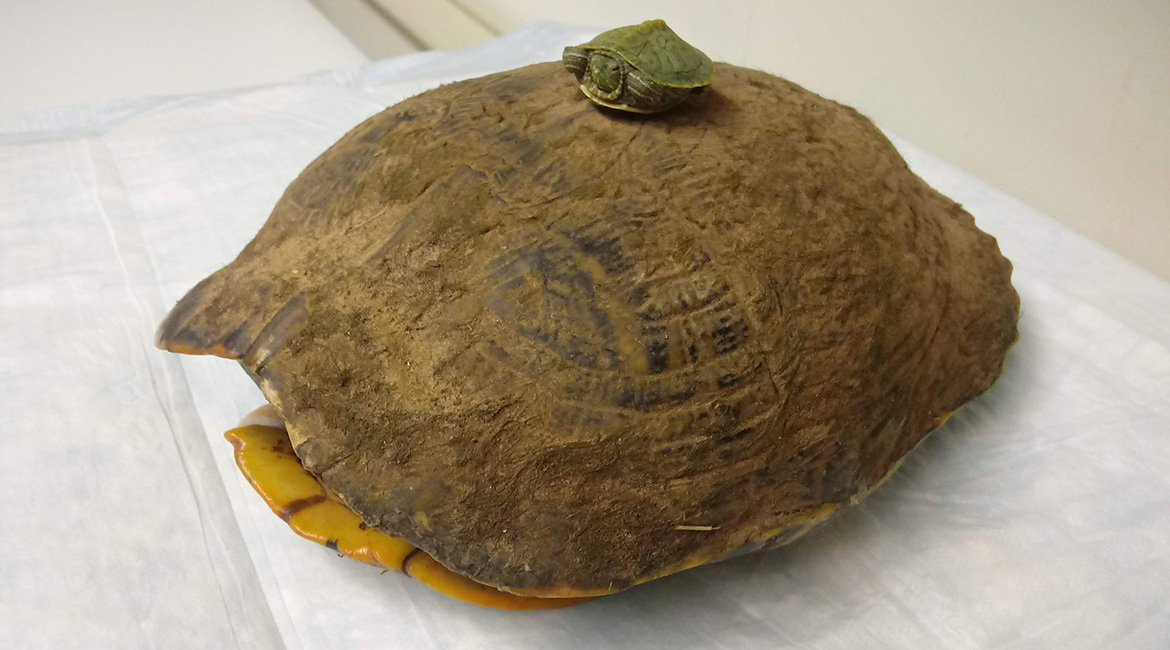
Wild Turtles are Not Pet Material
Monday, August 12, 2019
From mid-July through September, thousands of people visit Oklahoma’s lakes, rivers and other waterways to cool off and enjoy their summer. And many of them encounter Oklahoma’s wildlife, as animals also utilize the water and adjacent wilderness.
At this time of year, baby turtles are hatching out of eggs buried months earlier. Most egg nests were found and destroyed by raccoons, skunks and other predators. The lucky, undisturbed nests can see 30 to 40 turtles dig themselves out of the soil. They must remain hidden, however, and try to make it to the water and its aquatic vegetation quickly.
Once the baby turtles are above ground, their predators expand to include egrets, herons and even water snakes and bullfrogs. The turtles will grow on a diet of aquatic invertebrates, plants and algae. After many years, they will be large enough where their list of predators decreases, but they will remain leery and quick to hide in the water should you get too close to them. Only a few survive until maturation to breed and create the next generation of turtles.
If you see one of these hatchling turtles, you may very well be enamored by their large eyes, bright colors and patterns, and toddler-like demeanor. Some people may give into their impulse to keep such a beautiful creature as a pet. What they fail to realize is that their care requirements in captivity can be astonishing. A turtle’s needs can be easily met in the wild — lots of food, water, sunlight and space to meet their individual, social and ecological needs. Bringing them into your home means you are responsible for providing all of this.
Turtles need lots of food, foraging nearly every day. With all this food comes lots of waste. This is where most pet turtle owners run into problems. Aquatic turtles are infamous for odorous, difficult to clean enclosures. This is because the necessary space and volume of water are nearly always underestimated. Massive, three-stage filtration is essential to keep the water clean between changes. Turtles also need sunlight for proper growth and shell development. Many hatchling turtles that grow up in captivity end up with malformed, unhealthy shells and skeletons. Special full-spectrum UVB bulbs must be provided for all indoor turtles. Lastly, turtles are nervous, ingrained to avoid predators at all cost. While some can become accustomed to humans, all need adequate space to explore, hide, swim and climb out of the water to dry off and bask. All of this occurs naturally in a healthy wetland. It does not occur in an aquarium or small decorative pond that is set apart from the rest of the ecosystem.
Herpetoculture, the keeping of reptiles and amphibians as pets, is a hobby that has advanced since its growth in popularity in the late 20th century. Captive care requirements for many species of turtles are well known, and they can become happy healthy family pets. Investing in proper caging and lighting and ensuring access to proper nutrition and veterinary care are serious undertakings.
A breeder or supplier of a captive-bred turtle will be your best bet for a pet. A captive-bred pet gives you more species to choose from (as opposed to finding a local wild turtle), and you may be directed towards a species that best suits your needs in terms of size, diet and behavior. That little hatchling you found at the beach is likely to grow into a very large turtle. Some captive species remain smaller. Some turtles are fish eaters, some eat mostly plants, and others prefer hard-to-get items like mussels. Different turtle species also have different personalities, with some being more seclusive and others more outgoing. Captive-bred animals are a renewable resource, do not strain wild populations, are more likely to be healthy and are less likely to have parasites. The breeder is often a good resource on how to care for them.
If you see an injured wild turtle, call the OSU Veterinary Medical Hospital at 405-744-7000, ext. 1. The hospital’s Avian, Exotic and Zoological Medicine Service rehabilitates injured wildlife and treats exotic pets. If you have a pet turtle and have questions, call to schedule an examination to assess both your pet’s health and its captive care.
